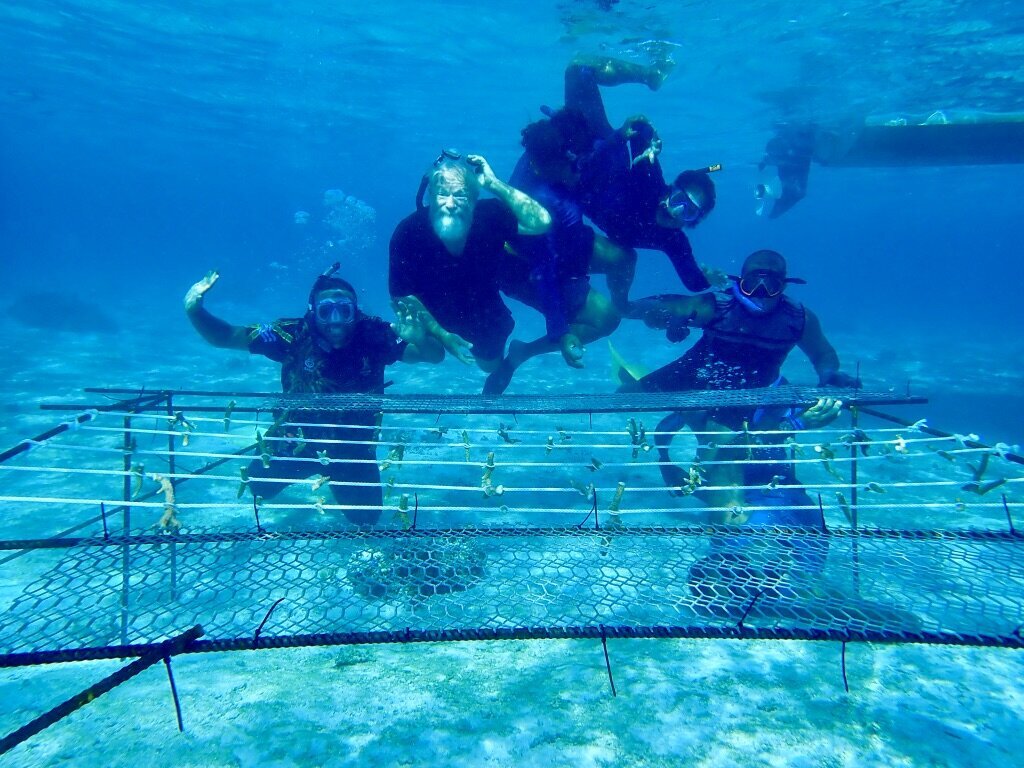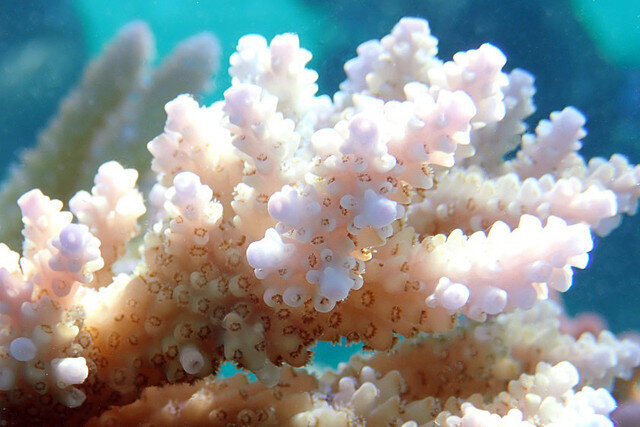Coral Restoration in Northern Lau for a Healthy and Safe Ocean
Written by Tyler Rae Chung, Vatuvara Foundation’s Marine Scientist
Coral reefs are known to have the highest biodiversity of any ecosystem on the planet. The survival of coral reefs are vital for a healthy and safe ocean around the world, now more than ever, especially within the remote islands of Fiji’s Northern Lau group. This diverse ecosystem acts as nurseries for most fish species consumed by local communities and protects coastlines against intense wave energy from tsunamis and cyclones. With the growing concern of the future for our ocean, Vatuvara Foundation is committed to conserving and reviving the health of our ocean in Northern Lau through partnerships, community engagement and innovative solutions. That is why we, the Vatuvara Foundation, believe that reviving the health of coral reefs will cause a rippling effect for a healthy and safe ocean.
Teamwork establishing the coral restoration nurseries in the lagoon © Vatuvara Foundation
In 2019, we started our coral restoration project, concentrating in the vast reef expanse lying between the islands of Yacata and Kaibu, two out of some sixty islands and islets that make up the Lau Group [1]. The first marine biological baseline surveys in Northern Lau were conducted by Vatuvara Foundation and Wildlife Conservation Society in 2017 [2]. The collaboration included the surveying of coral reef systems to assess coral health, fish abundance, biomass, and to investigate the damages to the surrounding marine ecosystem caused by Tropical Cyclone Winston. The lagoonal habitat between these two areas were among several important sites identified for protection and identified by the research team was the presence of crustose coralline algae, which in the world of coral, is a critical component for the settlement of new corals. From the marine biological baseline survey findings, Yacata Island community declared a part of their iqoliqoli (traditional fishing grounds) a tabu (marine protected area).
Vatuvara Foundation’s coral restoration project was borne out of the need to urgently address the detrimental effects our ocean is facing. Coral ecosystems face serious threats from the impacts of global climate change, unsustainable fishing, and land-based pollution. Between 2014 to 2017, the third global bleaching event took place, bleaching approximately 75 per cent of worldwide coral reefs. This was the longest, most widespread, and destructive bleaching event recorded [3]. The Foundation believes that science plays an integral role in the future of our ocean. We also believe in the close collaboration of science and the surrounding communities, as in the case of our project, there can only be positive impact on the ground. Our project works very closely with those whose life source is our study base. Their traditional knowledge of the ocean, that has been handed down through generations from their forefathers has enlightened our scientific knowledge. That is why our two project goals consist of the setting up of coral nurseries in the lagoon area and establishing community networks on the ground. The science component of establishing the coral nurseries will provide for a natural recovery and adaptation process for repopulating our surrounding reefs. This is done, in close partnership with youths in the communities, by identifying and creating mixed species of corals assemblages containing multiple genotypes of each species to increase spawning rates during out planting season (June to October) with the monitoring of restoration sites carried out by the Yacata Youth group and Vatuvara Foundation team on a regular basis. Through this hands-on approach, scientific knowledge and methods are passed onto the community, where youths can share this knowledge to the rest of their community. Enriching and empowering those around, becoming knowledgeable on the importance of coral restoration and reviving damaged reefs. Weaving together scientific methods, traditional knowledge, and tourism conservation.
Our coral team is made up of nine passionate and driven young women and men committed to protecting the reef in northern Lau. Their dedication, enthusiasm, and willingness to take the lead role in monitoring and cleaning of coral nurseries are indicative of the importance of this project. As a young, female Marine Scientist with the Vatuvara Foundation, a major highlight is working side by side with this dedicated young group from Yacata Island, who have taken ownership of their marine resources. Empowering and working with the young people of Yacata, the Foundation believes that it is only when young people take ownership of their environment that the future is hopeful and bright.
We had the privilege of being mentored by Dr Austin Bowden-Kerby, a renowned coral reef restoration expert also known as the “Coral Gardener” who won the National Geographic Ashoka Change Makers Award for the environment in 2011 and is dedicated to restoring Fiji’s reefs. Dr Bowden-Kerby trained Yacata youth and the Vatuvara Foundation team to survey the lagoon, identify and collect potential heat tolerant corals. He also assisted the team to construct a standard type nursery, which is a combination of a rope and cement disc “cookie” method. The coral restoration training by Dr Austin Bowden-Kerby gave the team confidence to adapt the methodology to cater for the unique marine ecosystem within the Kaibu and Yacata lagoon. Later that year, an out-planting coral training was led by Victor Bonito, the Director, and head scientist of Reef Explorer Fiji, along the coral coast of Viti Levu. Mr. Bonito has done tremendous work reviving and restoring corals reefs, showing successful outcomes of long-term coral restoration benefits.
Dr. Austin Bowden-Kerby with Yacata Island youth, constructing a standard type nursery. Table construction for “cookie” and rope method already entwined with coral fragments © Vatuvara Foundation
Determined to rebuild our surrounding reefs in Northern Lau, our team set out to establish three coral nurseries within our lagoon. The coral team ventured out during low tide to identify and collect corals from the reefs. Collecting coral species from the two genera of stony corals; Acropora and Pocillopora. These two species of coral are shown to have adaptive features, are fast growing and less susceptible to high temperature, that can aid with the natural recovery and the adaptation process for our project. For example, the highest annual sea surface temperature data downloaded from our deployed temperature loggers within the lagoon area had a record ranging from 30.9°C in 2017, 32.6°C in 2018 and 44.1°C in 2019. In 2019, Dr Bowden-Kerby and the team found a large patch of staghorn corals; Acropora aspera [4], that even though the tips were bleached, the coral colony was unbleached and abundant with fishes. This species of Acropora was set aside and labelled as our potential ‘heat tolerant’ coral and entwined onto ropes on our first nursery table, which was monitored throughout the year. Our nursery locations will assist with natural recovery as the ocean current flows downwards to the damaged reef area during spawning events. A year later, we have observed that these staghorn coral fragments have grown and have shown resistance and recovery during the hotter months (November to April).
Identified heat tolerant coral being entwined with rope by Dr. Austin Bowden-Kerby and Yacata youth group member and Foundation coral team, Ruci Vakadewavanua © Vatuvara Foundation
Monitoring the health and growth of the corals and cleaning of nurseries are conducted weekly, weather permitting. The Yacata youth group and Foundation team have taken the responsibility upon themselves in creating a team group chat to notify and update the health of corals within the nurseries. This year, the coral team is excited for the upcoming cooler weather for out planting. The youth group have expressed their amazement on the changes of the coral’s growth over the past year and look forward to sharing their experiences in coral restoration work.
Vatuvara Foundation Marine Scientist, Tyler Rae Chung, monitoring lagoon coral nurseries in Northern Lau © Vatuvara Foundation
Even though the traditional tabu or marine protected areas are the most natural ways to protect and restore coral reef systems. The establishment of coral nurseries and restoration sites assists the revival process through the selection of specific fragments of coral species grown in the nursery that can develop into “mother” colonies, which are a sustainable source colony for future fragmentation. Since the beginning of this year, the Vatuvara Foundation has been successfully growing over 400 corals in three coral restoration nurseries, all showing positive signs of attachment and significant growth in the lagoon.
It is our hope and intention that by restoring heat tolerant coral species systematically in the lagoon, we can revive our coral reef system. Working hard to look at ways to ensure that the corals in our lagoon are versatile and able to withstand the effects of the increasing sea temperatures. We not only want to restore our surrounding coral reef but strengthen resilience to the ‘tide’ of change, and to safeguard the livelihoods of the people whose main life source is dependent on the sea. The team continues to work with young adults in our surrounding island communities, encouraging the linkage between traditional knowledge, science-based approach and sustainable tourism to protect their oceanic backyard for future generations.
Growing coral fragment on the lagoon nursery © Vatuvara Foundation
[1] Conservation International (2018) Lau Seascape Strategy: 2018−2030. Conservation International, Suva, Fiji. 58 pp.
[2] Miller K, Nand Y, Mangubhai S, Lee S, Naisilisili W, Sykes H (2018) Marine Biological Surveys of the Northern Lau Group. Report No. 01/18. Vatuvara Foundation and the Wildlife Conservation Society, Suva, Fiji. 46 pp.
[3] National Oceanic and Atmospheric Administration. (2020, May 21). Retrieved from Coral Reefs - Office for Coastal Management - NOAA: https://coast.noaa.gov/states/fast-facts/coral-reefs.html
[4] http://www.coralsoftheworld.org/species_factsheets/species_factsheet_summary/acropora-aspera/





